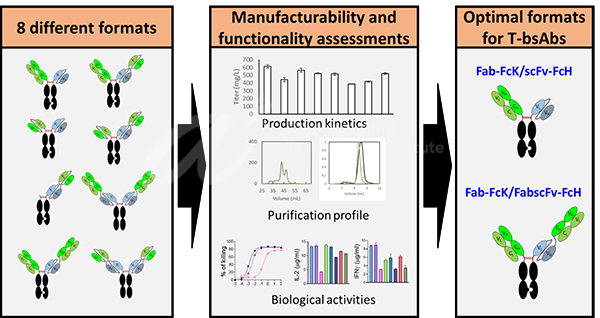Manufacturability and functionality assessment of different formats of T-cell engaging bispecific antibodies
Science
Bispecific antibodies (bsAbs) are novel therapeutics that can bind to two different antigens/epitopes to exert their functions. In particular, T-cell-engaging bispecific antibodies (T-bsAbs) have great potential in cancer treatment by redirecting T-cells to kill tumors. Despite these advantages, the array of available bsAb formats makes it challenging to choose the most suitable format for generating effective T-bsAbs. In this study, we conducted a systematic comparison of eight different T-bsAb formats to understand how the molecular design of these antibodies affects their manufacturability and functionality1. The insights gained from this study provides a basis for selecting the optimal format for T-bsAb development.
Societal Impact
Although extensive research has been done to identify parameters that contribute to good bsAb functionality, the effect of molecular designs on both functionality and manufacturability has not been systematically explored. Through our work, we identified critical parameters which are important for generating functional T-bsAbs with good manufacturability. Our findings offer valuable insights into optimizing the production and function of T-bsAbs through format design. Understanding the impact of different formats on T-bsAb manufacturability and functionality allows pharmaceutical companies to choose the most suitable formats for their specific therapeutic candidates. This can streamline drug development, reduce production challenges, and potentially accelerate the time to market for cancer immunotherapies.
Technical Summary
Many studies have explored the impact of molecular designs, such as binding affinity, valency, flexibility, and geometry, on bsAb functionality. Nevertheless, the effect of different molecular designs on both manufacturability and functionality has not been systematically studied. To address this gap in knowledge, we generated a panel of eight IgG-like T-bsAb formats in Chinese Hamster ovary cells and systematically evaluated each format for their titer, purification profile, binding affinity, and biological activities. These T-bsAbs were constructed using antigen-binding fragments (Fabs) and single-chain variable fragments (scFvs) linked to the Fc domain of immunoglobulin G. The T-bsAbs targets human CD3 and human epidermal growth factor receptor 2 (HER2).
Our results showed that increasing the number of scFv building blocks negatively impacted manufacturability, while functionality depended on various factors, including the binding properties of targeting moieties and format flexibility. Among the eight T-bsAb formats tested, we identified both the Fab-FcK/scFv-FcH and Fab-FcK/FabscFv-FcH as the optimal formats for developing Ig-like T-bsAbs in terms of both manufacturability and functionality.
Figure 1. Workflow for the systematic analysis of 8 T-bsAb formats for identification of formats with good manufacturability and functionality.
References
1. Loh, H. P. et al. Manufacturability and functionality assessment of different formats of T-cell engaging bispecific antibodies (2023) https://doi.org/10.1080/19420862.2023.2231129
A*STAR celebrates International Women's Day

From groundbreaking discoveries to cutting-edge research, our researchers are empowering the next generation of female science, technology, engineering and mathematics (STEM) leaders.
Get inspired by our #WomeninSTEM
.png?sfvrsn=1a7df424_3)
.jpg?sfvrsn=a6ab907d_0)
